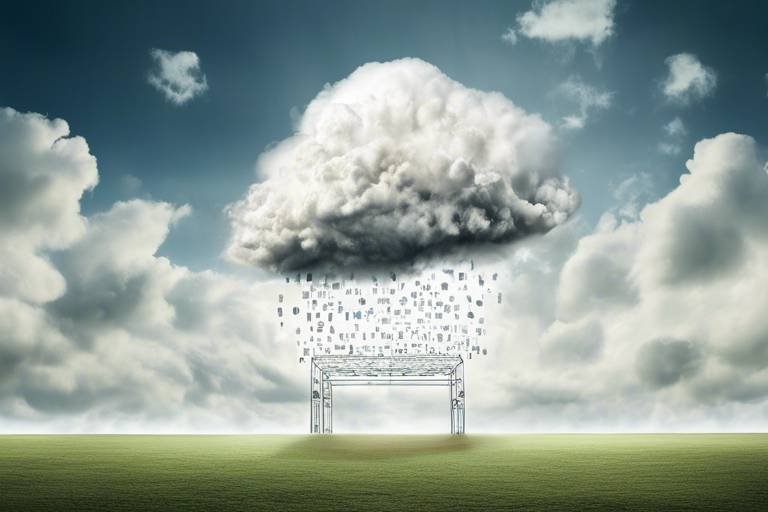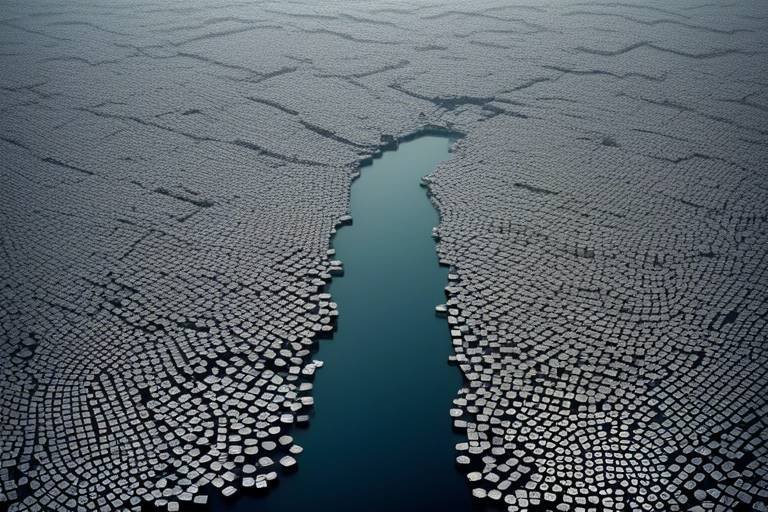Analyzing the Connection Between Climate Change and Rising Sea Levels
Climate change is not just a buzzword; it's a pressing reality that affects every corner of our planet. One of the most alarming consequences of this phenomenon is the rise in sea levels, which poses an existential threat to coastal communities worldwide. As we delve into this topic, it's essential to understand how climate change operates, the mechanisms behind rising sea levels, and the implications for both natural ecosystems and human settlements. This article will navigate through the science of climate change, the methods of measuring sea levels, and the socio-economic impacts that arise from this crisis.
Understanding the mechanisms of climate change is crucial. At its core, climate change is driven by an increase in greenhouse gases (GHGs) in the atmosphere, primarily carbon dioxide (CO2) and methane (CH4). These gases trap heat from the sun, leading to a gradual increase in global temperatures, commonly referred to as global warming. The scientific consensus is clear: human activities, such as burning fossil fuels, deforestation, and industrial processes, are the primary culprits behind this rise in GHGs. According to the Intergovernmental Panel on Climate Change (IPCC), we are already witnessing a rise of approximately 1.1°C since the late 19th century, with devastating effects on our climate systems.
Accurate measurement of sea levels is essential for understanding their rise. Various methods are employed to track changes in sea levels, each with its strengths and weaknesses. One of the most advanced techniques involves satellite technology, which uses radar altimetry to measure the distance from the satellite to the ocean surface. This method provides a comprehensive view of global sea level changes. Additionally, traditional tide gauges, which have been in use for over a century, measure the height of the ocean at specific locations. Both methods are crucial for creating a complete picture of how sea levels are changing over time.
As ocean temperatures rise, water expands, contributing significantly to sea level rise. This phenomenon, known as thermal expansion, occurs because water molecules move faster and occupy more space as they heat up. According to recent studies, thermal expansion accounts for about one-third of the observed sea level rise. In climate models, understanding thermal expansion is vital, as it helps predict future sea level scenarios under various greenhouse gas emission trajectories. Imagine a balloon: as you blow air into it, it expands. Similarly, as the oceans warm, they expand, pushing sea levels higher.
Rising sea levels threaten coastal ecosystems, including wetlands and mangroves, which are crucial for biodiversity. These habitats serve as nurseries for many marine species and act as natural barriers against storms and erosion. As sea levels rise, saltwater intrudes into freshwater habitats, disrupting the delicate balance of these ecosystems. The loss of wetlands and mangroves not only diminishes biodiversity but also reduces the natural protection these areas provide against flooding. The implications for wildlife are dire, with many species facing habitat loss and increased competition for resources.
Coastal communities face significant challenges due to rising sea levels. The risks to infrastructure, housing, and livelihoods in vulnerable areas are mounting. For instance, cities like Miami and New Orleans are already grappling with increased flooding and storm surges. As a result, local governments are forced to rethink urban planning and invest heavily in flood defenses. The reality is stark: entire communities may need to relocate, leading to social upheaval and economic loss. Can you imagine the emotional toll on families who have lived in the same place for generations, only to be forced to leave?
The melting of polar ice and glaciers is a major contributor to rising sea levels. As global temperatures rise, the ice caps in Greenland and Antarctica are experiencing unprecedented melting rates. Recent data indicates that Greenland alone is losing around 280 billion tons of ice annually. This melting not only contributes to sea level rise directly but also affects ocean circulation patterns, which can have further implications for global weather systems. Projections suggest that if current trends continue, we could see significant increases in sea levels, potentially exceeding 1 meter by the end of the century.
Rising sea levels have far-reaching socioeconomic consequences. The potential economic costs are staggering, with estimates suggesting that billions of dollars could be required for infrastructure repairs and adaptations. Furthermore, vulnerable communities, particularly in developing countries, may face insurmountable challenges in adapting to these changes. The loss of agricultural land, increased flooding, and the destruction of homes can lead to a cycle of poverty that is difficult to escape. It's not just about the physical loss; it's about the disruption of lives and communities.
As sea levels rise, populations may be forced to relocate, leading to climate migration. This phenomenon raises numerous challenges, from legal status to resource allocation in receiving communities. The implications of climate migration are profound, as displaced individuals often face discrimination and economic hardships in their new environments. Imagine the strain on cities that are already struggling to provide basic services; an influx of climate refugees could exacerbate existing issues, leading to social tensions and instability.
Effective policies are essential to address rising sea levels. Governments worldwide must prioritize strategies for mitigation and adaptation. This includes investing in resilient infrastructure, enhancing natural barriers like wetlands, and promoting sustainable practices that reduce greenhouse gas emissions. Collaboration between nations is crucial; after all, climate change knows no borders. By working together, we can develop comprehensive strategies that not only protect our coastlines but also safeguard the livelihoods of millions.
- What are the main causes of rising sea levels? Rising sea levels are primarily caused by thermal expansion of seawater and the melting of glaciers and ice caps.
- How does climate change affect coastal communities? Coastal communities face increased flooding, loss of land, and economic challenges due to rising sea levels.
- What can be done to mitigate the effects of rising sea levels? Effective policies, sustainable practices, and investments in resilient infrastructure are essential for mitigation.

The Science Behind Climate Change
Understanding the mechanisms of climate change is crucial for grasping the challenges we face today. At its core, climate change refers to long-term alterations in temperature, precipitation, and other atmospheric conditions on Earth. But what drives these changes? The answer lies primarily in greenhouse gases (GHGs), which trap heat in the atmosphere, creating a greenhouse effect that warms the planet. Think of it like a cozy blanket on a chilly night—great for keeping warm, but too much can lead to overheating!
Among the most significant greenhouse gases are carbon dioxide (CO2), methane (CH4), and nitrous oxide (N2O). These gases are produced through various human activities, such as burning fossil fuels for energy, deforestation, and agricultural practices. The concentration of these gases has skyrocketed since the Industrial Revolution, leading to a dramatic increase in global temperatures. According to the Intergovernmental Panel on Climate Change (IPCC), the Earth's average surface temperature has risen by about 1.2 degrees Celsius since the late 19th century. This may sound small, but it has profound implications for our climate.
Moreover, there is a strong scientific consensus that human activities are the primary driver of this climate change. A multitude of studies from reputable sources, including NASA and the World Meteorological Organization, confirm that the warming we are experiencing cannot be explained by natural factors alone. To put it simply, we are heating our planet at an unprecedented rate, and the consequences are becoming increasingly evident.
To visualize the impact of greenhouse gases, consider the following table that highlights the main contributors and their effects:
| Greenhouse Gas | Source | Impact |
|---|---|---|
| Carbon Dioxide (CO2) | Fossil fuel combustion, deforestation | Major contributor to global warming |
| Methane (CH4) | Agriculture, landfills, natural gas production | More potent than CO2 in the short term |
| Nitrous Oxide (N2O) | Agricultural fertilizers, industrial processes | Contributes to ozone depletion |
As we delve deeper into the science, it's essential to recognize that climate change is not just a future problem; it's happening now. Extreme weather events, rising temperatures, and shifting ecosystems are all evidence of a changing climate. For instance, we see more frequent and severe hurricanes, droughts, and wildfires, which can be linked to the warming atmosphere. This is not just a statistic; it's becoming a reality for millions of people around the world.
In summary, the science behind climate change is complex, but the message is clear: human activity is a significant driver of the changes we are witnessing. Understanding this connection is vital for developing effective solutions to mitigate its effects. As we move forward, we must consider how our actions today will shape the world of tomorrow.
- What are greenhouse gases? Greenhouse gases are gases that trap heat in the atmosphere, contributing to the greenhouse effect.
- How does climate change affect weather patterns? Climate change can lead to more extreme weather events, including hurricanes, droughts, and heavy rainfall.
- What can individuals do to combat climate change? Individuals can reduce their carbon footprint by using energy-efficient appliances, reducing waste, and supporting renewable energy sources.

How Sea Levels Are Measured
Accurate measurement of sea levels is essential for understanding the dynamics of our oceans and the implications of rising waters on coastal communities. But how exactly do scientists measure sea levels? It's not just a matter of sticking a ruler in the water and calling it a day! There are several sophisticated methods in place that provide us with precise data, each with its own strengths and applications.
One of the primary tools used to measure sea levels is satellite altimetry. This technology utilizes satellites equipped with radar systems that send signals down to the ocean surface. By measuring the time it takes for the signals to bounce back, scientists can determine the distance to the sea surface with remarkable accuracy. Satellite altimetry allows us to monitor vast areas of the ocean at once, providing a comprehensive view of sea level changes over time.
Another important method is the use of tide gauges. These devices are installed along coastlines and measure the height of the water relative to a fixed point on land. Tide gauges have been used for over a century, and they provide valuable long-term data that can be compared with satellite measurements. However, they are limited to localized areas, which means they may not capture broader oceanic trends.
In addition to these methods, scientists are also exploring the use of buoys equipped with advanced sensors. These buoys float on the ocean surface and can record various parameters, including sea level, temperature, and salinity. The data collected by buoys can help validate satellite measurements and tide gauge readings, contributing to a more accurate overall picture of sea level changes.
It's important to note that measuring sea levels is not just about observing the water itself. Geodetic measurements that account for land movement, such as subsidence or uplift, are also crucial. For instance, if a coastal area is sinking due to geological processes, it may appear as though sea levels are rising faster than they actually are. This interplay between land and sea is complex and requires a multi-faceted approach to fully understand.
Here's a quick overview of the methods used to measure sea levels:
| Method | Description | Advantages |
|---|---|---|
| Satellite Altimetry | Uses satellites to measure sea surface height | Covers large areas, provides global data |
| Tide Gauges | Measures water height at fixed coastal points | Long-term historical data, reliable for local trends |
| Buoys | Floating devices that record ocean parameters | Can validate other measurements, flexible locations |
| Geodetic Measurements | Accounts for land movement affecting sea levels | Provides a comprehensive view of sea level changes |
In conclusion, measuring sea levels is a complex but vital task that combines multiple technologies and methodologies. Each method contributes to our understanding of how climate change is impacting our oceans and coastal areas. By employing these advanced techniques, scientists can provide insights that are crucial for planning and adaptation strategies in the face of rising sea levels.
- What is the most accurate method for measuring sea levels? Satellite altimetry is considered one of the most accurate methods as it provides global coverage and precise measurements.
- How do tide gauges work? Tide gauges measure the height of the water at fixed coastal points, allowing for the tracking of sea level changes over time.
- Why is it important to account for land movement? Land movement can affect the perceived rate of sea level rise, so accounting for it provides a more accurate understanding of changes.

The Role of Thermal Expansion
When we talk about climate change, one of the less visible but equally impactful processes at play is thermal expansion. This phenomenon occurs when water heats up and expands, leading to an increase in sea levels. Imagine a balloon that gets bigger when you blow hot air into it; the same principle applies to our oceans. As global temperatures rise due to greenhouse gas emissions, the heat penetrates the ocean's surface, causing the water to swell. In fact, thermal expansion is responsible for about one-third of the observed rise in sea levels over the past century.
The mechanics of thermal expansion are fascinating yet alarming. As the average ocean temperature increases, the water molecules move faster and spread apart. This expansion contributes significantly to rising sea levels, making it a critical factor in climate models. To illustrate, let’s look at some data:
| Year | Global Average Sea Level Rise (mm) | Contribution from Thermal Expansion (mm) |
|---|---|---|
| 1993 | 0.3 | 0.1 |
| 2003 | 2.8 | 1.2 |
| 2013 | 6.7 | 2.3 |
| 2023 | 10.5 | 3.5 |
As shown in the table, the contribution of thermal expansion to sea level rise has been increasing over the years. This trend raises several questions: What does this mean for coastal cities? How do we prepare for the inevitable? The answers lie in understanding the broader implications of thermal expansion.
Thermal expansion doesn't just affect sea levels; it also has a ripple effect on marine ecosystems. As water temperatures rise, the habitats of various marine species are altered, potentially leading to shifts in biodiversity. For instance, coral reefs, which are already under stress from warming waters, face further challenges as the ocean expands and changes its chemistry. This can lead to coral bleaching, a phenomenon that devastates these vibrant ecosystems.
Moreover, thermal expansion can exacerbate the effects of storm surges and tidal flooding. When high tides coincide with storms, the elevated sea levels can lead to catastrophic flooding in coastal areas. This situation puts immense pressure on infrastructure, local economies, and the livelihoods of millions of people. The stakes are high, and understanding thermal expansion is crucial for developing effective mitigation strategies.
In conclusion, thermal expansion is a vital piece of the climate change puzzle. As we continue to grapple with the realities of rising sea levels, we must prioritize research and policy-making that addresses both the causes and effects of this phenomenon. Only by doing so can we hope to protect our coastal communities and preserve the delicate balance of our marine ecosystems.
- What is thermal expansion? - Thermal expansion refers to the increase in volume of water as it warms up, contributing to rising sea levels.
- How much does thermal expansion contribute to sea level rise? - It accounts for about one-third of the observed sea level rise over the past century.
- What are the implications of thermal expansion for coastal communities? - Coastal communities face increased flooding risks, infrastructure challenges, and potential displacement of populations.
- How can we mitigate the effects of thermal expansion? - Effective policies, infrastructure improvements, and sustainable practices are essential for adaptation and mitigation.

Impact on Coastal Ecosystems
As sea levels continue to rise, the effects on coastal ecosystems become increasingly pronounced, creating a ripple effect that threatens not just the environment but also the communities that rely on these vital habitats. Coastal ecosystems, such as wetlands, mangroves, and coral reefs, serve as crucial buffers against storm surges and flooding, while also providing habitat for a diverse array of wildlife. However, with the relentless march of climate change, these ecosystems are facing unprecedented challenges.
One of the most significant impacts of rising sea levels is the loss of habitat. As saltwater intrudes into freshwater systems, many plants and animals that are not adapted to saline conditions struggle to survive. For instance, wetlands, which act as natural sponges, are increasingly submerged, leading to a decline in their ability to filter pollutants and provide habitat for fish and birds. The loss of these habitats can trigger a domino effect, leading to reduced biodiversity and the potential extinction of species that rely on these ecosystems for survival.
Moreover, the intrusion of saltwater into estuaries can disrupt the delicate balance of these ecosystems. Species that thrive in freshwater environments may find it difficult to adapt to the changing conditions, leading to a decline in fish populations that are vital for local fisheries. This not only affects the ecosystem but also the livelihoods of communities that depend on fishing as a primary source of income. The economic implications are staggering, as the loss of fish stocks can lead to food insecurity and increased poverty in coastal regions.
To illustrate the severity of these changes, consider the following table that outlines the potential impacts of rising sea levels on various coastal ecosystems:
| Coastal Ecosystem | Impact of Rising Sea Levels | Potential Consequences |
|---|---|---|
| Wetlands | Submersion and saltwater intrusion | Loss of biodiversity, reduced water quality |
| Mangroves | Increased flooding and erosion | Habitat loss, decreased protection from storms |
| Coral Reefs | Increased water temperature and acidification | Coral bleaching, loss of marine life |
In addition to these ecological impacts, the rise in sea levels also poses a threat to the cultural heritage of coastal communities. Many coastal areas are home to indigenous populations whose way of life is intricately linked to the health of their surrounding ecosystems. As these ecosystems deteriorate, so too does their cultural identity, leading to a loss of traditional knowledge and practices that have been passed down through generations.
In conclusion, the impact of rising sea levels on coastal ecosystems is a multifaceted issue that requires urgent attention. From habitat loss to economic challenges, the consequences are far-reaching and affect not just the environment but also the very fabric of human society. Addressing these issues through sustainable practices and effective policy responses is essential to mitigate the effects of climate change and protect our coastal ecosystems for future generations.
- What are the main causes of rising sea levels? Rising sea levels are primarily caused by thermal expansion of seawater due to global warming and the melting of ice caps and glaciers.
- How do rising sea levels affect coastal communities? Coastal communities face risks such as flooding, loss of land, and threats to infrastructure, which can lead to economic instability and displacement.
- What can be done to protect coastal ecosystems? Implementing sustainable practices, restoring habitats, and creating policies focused on climate adaptation can help protect these vital ecosystems.

Influence on Human Settlements
The impact of rising sea levels on human settlements is nothing short of alarming. Imagine living in a beautiful coastal town, where the sound of waves lapping against the shore is your daily soundtrack. Now imagine that same town slowly disappearing beneath the rising tides. This is the harsh reality for many communities around the globe. As sea levels continue to rise, coastal areas face significant challenges that threaten their very existence.
One of the most pressing concerns is the risk to infrastructure. Roads, bridges, and public utilities are all at risk of flooding, which can lead to costly repairs and, in some cases, complete loss of functionality. For instance, cities like Miami and New Orleans are already experiencing frequent flooding during high tide, making daily life increasingly difficult for residents. The question arises: how long can these cities sustain their current infrastructure before it becomes obsolete?
Moreover, the threat to housing is profound. Many homes in coastal regions are built just a stone's throw from the water's edge. As sea levels rise, these houses are not only at risk of flooding but also of erosion. Homeowners may find themselves in a precarious situation where their property values plummet, and insurance becomes increasingly difficult to obtain. In some cases, entire neighborhoods may need to be abandoned, leading to a loss of community and heritage.
Furthermore, the economic implications of rising sea levels cannot be overlooked. Coastal communities often rely on tourism, fishing, and other industries that are directly tied to their proximity to the ocean. As beaches erode and storms become more frequent, these industries face severe challenges. For example, a study by the National Oceanic and Atmospheric Administration (NOAA) estimates that the economic costs of rising sea levels could reach billions of dollars annually by 2050. This raises an important question: how will communities adapt to such drastic changes in their economic landscape?
In addition to these challenges, rising sea levels can lead to social displacement. As areas become uninhabitable, residents may be forced to relocate, leading to a host of social issues. Families may be separated, cultural ties may weaken, and communities may struggle to find adequate housing in less vulnerable areas. This creates a ripple effect that can strain resources in neighboring regions, leading to increased tensions and competition for housing and jobs.
To illustrate the potential impact of rising sea levels on human settlements, consider the following table:
| Aspect | Impact |
|---|---|
| Infrastructure | Increased flooding, costly repairs, and potential loss of functionality |
| Housing | Risk of erosion, decreased property values, and potential abandonment |
| Economy | Threat to tourism and local industries, potential loss of billions |
| Social Displacement | Forced relocations, weakened community ties, and resource strain |
In conclusion, the influence of rising sea levels on human settlements is a multifaceted issue that requires urgent attention. As we navigate the complexities of climate change, it is essential to consider innovative solutions and proactive measures to protect our coastal communities. The time to act is now, before the waves wash away not just the land, but the very fabric of our society.
- What causes rising sea levels? Rising sea levels are primarily caused by thermal expansion of seawater due to global warming and the melting of ice caps and glaciers.
- How do rising sea levels affect coastal communities? Coastal communities face risks to infrastructure, housing, and livelihoods, which can lead to economic and social challenges.
- What can be done to mitigate the effects of rising sea levels? Mitigation strategies include improving infrastructure, implementing sustainable practices, and developing policies for adaptation.

Melting Ice Caps and Glaciers
The phenomenon of is one of the most striking indicators of climate change. Picture this: vast expanses of ice that have stood for millennia are now shrinking at an alarming rate. This isn't just a distant issue; it's happening right now, affecting our planet's delicate balance. The polar regions, particularly Greenland and Antarctica, are losing ice, and the implications of this loss are profound.
To put it into perspective, the Greenland ice sheet alone is losing approximately 280 billion tons of ice each year. This melting contributes significantly to rising sea levels, exacerbating the challenges faced by coastal communities worldwide. In fact, a recent study indicated that if the Greenland ice sheet were to melt entirely, global sea levels could rise by about 7 meters (approximately 23 feet). Can you imagine the impact that would have on cities like New York, Miami, or Tokyo?
But what’s causing this accelerated melting? The answer lies in a combination of factors, primarily linked to global warming. As greenhouse gas emissions increase, they trap heat in the atmosphere, leading to higher temperatures. This warming affects the oceans, which in turn warms the ice sheets from below. The result? A vicious cycle of melting that feeds back into the climate crisis.
Moreover, the melting of glaciers and ice caps isn't just a matter of rising sea levels. It also has a cascading effect on global weather patterns. For instance, the loss of ice alters the Earth's albedo effect, which is the measure of how much sunlight is reflected back into space. Less ice means more absorption of heat, further accelerating climate change. This creates a feedback loop that is difficult to break.
To illustrate the urgency of this situation, let’s look at some figures:
| Region | Ice Loss (billion tons/year) | Potential Sea Level Rise (meters) |
|---|---|---|
| Greenland | 280 | 7 |
| Antarctica | 200 | 6 |
| Glaciers Worldwide | 150 | 0.5 |
As we observe these changes, it’s essential to consider the broader implications. The melting ice caps and glaciers not only threaten coastal regions but also disrupt ecosystems. Species that depend on ice-covered regions, such as polar bears and seals, face habitat loss. The very fabric of our natural world is being altered, and the consequences may be irreversible.
In conclusion, the melting of ice caps and glaciers is a clear sign of the urgent need for action. It serves as a reminder that our planet is in distress and that we must take steps to mitigate climate change. Whether it’s reducing our carbon footprint, supporting renewable energy initiatives, or advocating for policy changes, every action counts. The time to act is now, before the ice melts away completely.
- What are the main causes of ice cap melting? The primary causes include global warming due to greenhouse gas emissions, ocean warming, and changes in atmospheric conditions.
- How does melting ice contribute to sea level rise? Melting ice caps and glaciers add additional water to the oceans, which raises sea levels. The Greenland and Antarctic ice sheets are particularly significant contributors.
- What can individuals do to help combat climate change? Individuals can reduce their carbon footprint by using public transport, conserving energy, reducing waste, and supporting sustainable practices.

Socioeconomic Impacts of Rising Sea Levels
Rising sea levels, a consequence of climate change, are not just an environmental issue; they pose significant socioeconomic challenges that can alter the very fabric of coastal communities. Imagine a bustling seaside town, thriving on tourism and local fisheries, suddenly facing the threat of inundation. The repercussions extend beyond just physical displacement; they ripple through economies, cultures, and social structures, creating a complex web of challenges that need to be addressed.
One of the most immediate impacts of rising sea levels is the threat to infrastructure. Coastal roads, bridges, and buildings are increasingly at risk of flooding. In many cases, local governments are forced to allocate funds for emergency repairs rather than investing in essential services like education or healthcare. This not only drains financial resources but also puts immense pressure on local economies. For instance, a town that relies heavily on tourism may see a decline in visitors if access routes are compromised, leading to a domino effect on local businesses.
Furthermore, the impact on agriculture cannot be overlooked. Saltwater intrusion into freshwater sources can render farmland unusable, affecting food production and driving up prices. Farmers may find themselves unable to sustain their livelihoods, leading to economic instability in the region. As agricultural productivity declines, the cost of food rises, disproportionately affecting low-income families who already struggle to make ends meet. This raises a critical question: How do we ensure food security in the face of such challenges?
As communities grapple with these changes, displacement and migration become pressing issues. People living in vulnerable areas may be forced to relocate, leading to a phenomenon known as climate migration. This migration can strain resources in receiving areas, potentially leading to conflicts over housing, jobs, and social services. The challenge of integrating displaced populations can further complicate the social fabric of communities that are already facing their own struggles.
In response to these challenges, effective policy measures are essential. Governments must prioritize adaptation strategies that not only protect existing communities but also promote sustainable practices. This could include investing in resilient infrastructure, such as sea walls and flood barriers, as well as implementing policies that encourage the restoration of natural ecosystems like wetlands and mangroves, which can act as buffers against rising waters.
To provide a clearer picture of the socioeconomic impacts, consider the following table that outlines potential costs associated with rising sea levels:
| Impact Area | Potential Costs |
|---|---|
| Infrastructure Damage | $1 trillion by 2050 |
| Displacement and Migration | $20 billion annually |
| Agricultural Losses | $30 billion by 2030 |
| Tourism Decline | $50 billion by 2040 |
The figures above illustrate just how severe the economic implications of rising sea levels can be. It is crucial for both policymakers and communities to understand these impacts and prepare accordingly. As we navigate this complex issue, the question remains: What steps can we take today to safeguard our future?
- What are the primary causes of rising sea levels? Rising sea levels are mainly caused by thermal expansion of seawater and the melting of glaciers and ice sheets.
- How do rising sea levels affect coastal communities? They threaten infrastructure, displace populations, and disrupt local economies, particularly in tourism and agriculture.
- What can be done to mitigate these impacts? Strategies include investing in resilient infrastructure, restoring natural ecosystems, and implementing sustainable practices.

Displacement and Migration
As we witness the relentless rise of sea levels, the phrase "climate refugees" is becoming more than just a buzzword; it’s a harsh reality for many. Imagine waking up to find your home slowly being swallowed by the ocean. This is the daunting future that countless coastal communities face as rising sea levels force them to abandon their homes. The implications of this displacement are profound, affecting not just individuals and families, but entire cultures and economies.
Displacement due to rising sea levels is not a distant threat; it is happening now. Coastal cities like Miami, New Orleans, and parts of Bangladesh are already experiencing the effects. Communities are grappling with the loss of their homes, livelihoods, and even their identities. The question arises: where do these displaced populations go? The options are limited and often fraught with challenges. Many end up in overcrowded urban areas, straining resources and infrastructure that are already under pressure.
Moreover, the issue of climate migration is not just about physical relocation; it’s about emotional and psychological impacts as well. The sense of loss and the struggle to adapt to new environments can lead to mental health challenges. Families are torn apart, and social networks are disrupted. The fabric of these communities is at risk of fraying, leading to a loss of cultural heritage and community cohesion.
To illustrate the scale of this issue, consider the following table that outlines projected displacement due to rising sea levels:
| Region | Projected Displacement by 2050 |
|---|---|
| South Asia | Up to 40 million |
| East Asia | Up to 20 million |
| North America | Up to 13 million |
| Sub-Saharan Africa | Up to 10 million |
This table highlights that the problem of displacement is not confined to one part of the world; it is a global crisis that requires urgent attention. Governments and organizations must come together to create comprehensive plans that address the needs of displaced populations. This includes not only immediate relief efforts but also long-term strategies for resettlement and integration into new communities.
In conclusion, the displacement caused by rising sea levels is a complex issue that intertwines environmental, social, and economic factors. As we look towards the future, it is crucial to recognize that the effects of climate change will not only alter landscapes but also the lives of millions. The time to act is now, to mitigate the impacts of climate change and to ensure that we are prepared for the challenges of tomorrow.
- What are climate refugees? Climate refugees are individuals or groups who are forced to leave their homes due to sudden or gradual changes in their environment related to climate change, such as rising sea levels.
- How does rising sea level affect migration? Rising sea levels can inundate homes, making areas uninhabitable, which forces people to relocate to safer areas.
- What can be done to help displaced populations? Governments and organizations can implement policies for disaster preparedness, provide financial assistance, and create sustainable resettlement programs.

Policy Responses and Mitigation Strategies
Addressing the challenges posed by rising sea levels requires a multifaceted approach, combining effective policy responses and innovative mitigation strategies. As we navigate the turbulent waters of climate change, it becomes increasingly evident that inaction is not an option. Governments, organizations, and communities must unite to develop comprehensive plans that not only protect vulnerable coastal areas but also promote sustainable practices that can withstand the test of time.
One of the most critical steps is the implementation of coastal management policies that prioritize both protection and adaptation. This includes investing in infrastructure improvements, such as building seawalls and restoring natural barriers like wetlands and mangroves, which can absorb storm surges and reduce erosion. For instance, a recent study highlighted how restoring mangrove forests can significantly lower the impact of rising sea levels, acting as a natural shield for coastal communities.
Furthermore, it is essential to integrate climate resilience into urban planning. This means rethinking how we design our cities and towns, ensuring that new developments are built with the future in mind. Incorporating green spaces, elevating buildings, and creating flood-resistant infrastructure are just a few methods that can make a significant difference. By doing so, we can mitigate the risks posed by rising sea levels while enhancing the overall quality of life for residents.
Another vital component of effective policy responses is the promotion of sustainable practices that reduce greenhouse gas emissions. Transitioning to renewable energy sources, such as solar and wind power, not only helps combat climate change but also fosters economic growth and job creation. Governments can incentivize this transition through subsidies and tax breaks, making it easier for businesses and individuals to adopt cleaner technologies.
Moreover, community engagement plays a crucial role in developing successful strategies. Local populations often have valuable insights into the challenges they face and can contribute to the creation of tailored solutions. By fostering partnerships between governments, NGOs, and community members, we can ensure that policies are not only effective but also equitable and inclusive.
In addition, international cooperation is paramount. Climate change knows no borders, and rising sea levels affect countries worldwide. Collaborative efforts, such as sharing research, resources, and best practices, can enhance our collective ability to address these pressing issues. Global agreements, like the Paris Agreement, provide a framework for nations to commit to reducing emissions and adapting to climate impacts.
In conclusion, navigating the complexities of rising sea levels requires a comprehensive approach that encompasses policy innovation, community involvement, and international collaboration. By prioritizing sustainability and resilience, we can not only protect our coastal communities but also pave the way for a healthier planet. The time to act is now, and the strategies we implement today will determine the future we leave for generations to come.
- What are the main causes of rising sea levels? Rising sea levels are primarily caused by thermal expansion of seawater as it warms and the melting of ice caps and glaciers.
- How can communities prepare for rising sea levels? Communities can prepare by investing in infrastructure improvements, restoring natural barriers, and incorporating climate resilience into urban planning.
- What role does international cooperation play in addressing climate change? International cooperation is crucial for sharing resources, research, and best practices to combat climate change effectively.
- How can individuals contribute to mitigation efforts? Individuals can contribute by reducing energy consumption, supporting renewable energy, and advocating for sustainable policies in their communities.
Frequently Asked Questions
- What is the main cause of rising sea levels?
The primary driver of rising sea levels is climate change, which leads to two main phenomena: thermal expansion of seawater as it warms and the melting of ice caps and glaciers. As temperatures increase, the ocean absorbs heat, causing the water to expand, while the melting ice adds more water to the oceans.
- How are sea levels measured?
Sea levels are measured using a combination of satellite technology and tide gauges. Satellites provide a global view of sea level changes, while tide gauges offer localized measurements. Together, these methods help scientists track sea level rise accurately over time.
- What impact does rising sea levels have on coastal ecosystems?
Rising sea levels pose a significant threat to coastal ecosystems such as wetlands, mangroves, and coral reefs. These habitats are essential for biodiversity and provide crucial services like storm protection and carbon storage. As sea levels rise, these areas can become submerged or suffer from increased salinity, disrupting the delicate balance of these ecosystems.
- How does rising sea level affect human settlements?
Coastal communities face numerous challenges due to rising sea levels, including the risk of flooding, erosion, and damage to infrastructure. Homes, roads, and essential services may be at risk, leading to potential economic losses and displacement of residents. This situation raises urgent questions about how to adapt and protect these vulnerable areas.
- What are the socioeconomic consequences of rising sea levels?
The socioeconomic impacts of rising sea levels are profound. They can lead to increased costs for disaster response, loss of property, and disruption of livelihoods, particularly in industries like fishing and tourism. Additionally, vulnerable populations may face displacement, leading to climate migration and further strain on resources in receiving areas.
- What strategies can be implemented to mitigate the effects of rising sea levels?
Mitigation strategies include improving infrastructure to withstand flooding, restoring natural barriers like wetlands, and implementing sustainable land-use practices. Policymakers must also prioritize community education and engagement to foster resilience and adaptation to the changing environment.



















